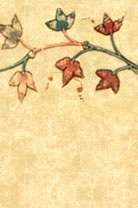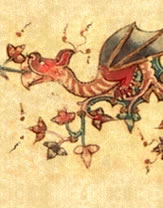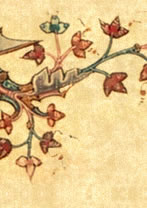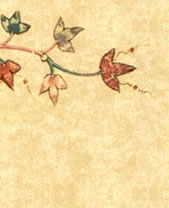|
We realize that some of you will be frightened, intimidated and overwhelmed by the prospect of putting together a medieval costume for the wedding. However, the look is quite simple and can be done inexpensively.


The early medieval period is characterized by relatively simple shapes, with decoration chiefly being in the form of woven and block printed fabrics. Women typically wore at least two layers; the outer garment would be shorter and have shorter sleeves, and would be more heavily decorated at the hem, neck and cuffs, and potentially at the middle arm and in a second row above the hem. The shape of each garment was essentially a “T”, with the arms sticking straight out from the shoulders, and with little shape to the waist - a belt was always worn to control the fullness of the garment.
Later in the period, women began to shape their clothing with the addition of triangular pieces of fabric (gores), inserted in the sides of the tunics at the armhole or waist to make the line of the tunic flare outward. Clothing had very little in the way of fastenings, being mainly pulled over the head, but in about the 12th century, women began to lace the sides of their dresses tighter across the middle, to produce a more form-fitting silhouette. (note: in the 14th century buttons came into vogue. These were made of metal, bone or wood. You can use buttons as fastenings or use lacing – both are appropriate)
Very long under-dress sleeves were fashionable, often being made long enough to extend right over the hand. (Tippets) To enable the use of the hands, sleeves were made tight enough that the wrists would not slide over the hands, but instead force the fabric to wrinkle and bunch along the forearm, creating a fairly narrow silhouette that was not binding or constrictive. The overdress sleeves gradually grew longer, and then wider as they began to approach the wrist. Soon the characteristic shape of the outer sleeve became a normal width until the middle of the forearm, where it widened out into a bell or trumpet shape that could be as wide as three or four feet.
Coarsely woven hose were worn on the legs, usually held up by garters or ties. Shoes remained fairly functional, although pointed toes began to become fashionable in the 13th century.
The hair of unmarried women could be worn loose or uncovered; married women ordinarily wore a veil over their hair, and often a wimple wound about the head and neck under the veil.
Throughout most of the 14th century, men's hair was worn at a medium length, sometimes curled, and faces were generally clean-shaven. In the early part of the century, they went bare-headed or wore hood and liripipe,


As appealing as it might seem to go barefoot, only some early Celtic sorts and some assorted barbarians went barefoot on a regular basis. Most shoes were fairly simple, and nearly all the sewn styles were made out of very soft leather or cloth, since the widespread use of a separate sole came somewhat later in the renaissance period. To protect shoes outside, wooden clogs could be strapped onto the feet.
Most of the earlier shoes had their principal seam running up the top of the foot, with the heel piece sewn in behind, and were tied or wrapped around the ankle to stay closed. A later development was the lacing of the shoe over the vamp, or the use of a strap and buckle. Pointed shoes came into fashion during Edward's reign, and were also restricted. The nobility were allowed 24" of pointed shoe beyond the natural foot, gentlemen 12" and commoners 6 1/2".

Both men and women can use a good, sturdy leather belt. Look for them in thrift shops, or look for simple belt buckles and make your own.
Knee high moccasins or boots for either sex, or "Mary Janes" for women works well, or flat pump style shoes in a natural color. If you are a peasant, leather sandals will also work, especially if they are laced. A pouch to hang off your belt can be made of leather or fabric.
Medieval peoples carried their own eating utensils with them
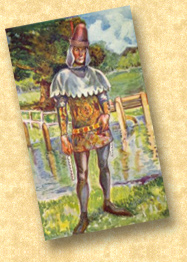

Eating utensils of the period were the spoon, the cup and the knife. Forks were used in Italy but were considered a novelty and not used at all in the rest of Europe. Everyone would have been expected to bring their own utensils. While this made the knife a usual item to be worn on the belt, it did still limit knives for eating to ones that could conceivably be used to do so. Throwing knives, large hunting knives, and other sizeable double-bladed knives were used for other purposes and would have been worn while engaging in those pursuits, but not for social occasions.
Swords, on the other hand, were definitely a fashion accessory for the medieval gentleman. The broadsword, so beloved by medieval fighters, was an enormous weapon that would have been worn in conjunction with other battle accoutrements, but not in the feast hall. The rapier, because of its relatively small size and light weight, was worn by most gentlemen of means towards the later part of our period (Lord von Holt disagrees! The first rapiers did not make an appearance until the 15th century - rapiers weren't around in the 14th century). The hilts were often quite elaborate, and also used as an elegant place to rest one's off hand when in a casual stance.
Jewelry varied widely, even within a particular period. As a general rule, though, it became more ornate as time passed. Take a look at the portraits in some of the costume resources for a better idea. Women did have pierced ears quite early on, as did many men. Watches did not really exist, and were not worn.
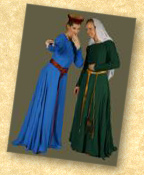

Maidens normally wore their hair loose, which symbolized virginity (married women wore their hair up and mostly covered). Hair was frequently braided and looped with flowers and jewels added. Fresh or silk ivy, silk or dried flowers, rose buds, etc., are all wonderful in loose hair or woven into braids.
A square of linen called a wimple was wrapped under the chin and fastened at the top of the head, draping to form a soft frame. A veil of similar material was placed over the top of the head, covering the fastening of the wimple. A circlet of some variety could be used to hold the veil in place. An alternative to the wimple was a narrower band of linen called a barbette, which fit snugly under the chin, and was also worn with a veil. Atop the barbette, some women wore a small, pillbox-like hat, or a stiffened open oval.
For a removable head piece, use a piece of flexible wire (light coat hanger or heavy floral wire) and wrap it from end to end with white or green floral tape. Form it into a circle that fits comfortably on your head. Secure the two ends together with floral tape. Add the dried or silk, or on the morning of the wedding gently secure fresh, flowers or ivy strands to the circle in several places with floral tape. Leave it in the refrigerator, maybe on top of a wet cloth in a Tupperware container. You could add colored ribbons, pearls, cords, tulle or silk flowers to the headband as to your taste.
Men’s hair grew longer and longer as hemlines grew shorter. Toward the end of the century, so as not to compete with the high collars of their clothing, men cropped their hair quite short.

The thing to remember is that the basic Medieval look is Women in gowns, Men in tights and tunics. Also keep in mind that this wedding is in August. Silks, linens and linen-look fabrics are best. Avoid heavy fabrics or anything synthetic (even if it looks the part) for your overall costume. We do not want anyone passing out from heat exhaustion. Limit those items to trim and accessories that can be removed (i.e. capes, purses etc.)
Medieval people did not purchase clothing specific for a wedding, they wore the best that they had. For those of you who wish to be nobles or merchant class – that would mean beautiful fabrics, jewelry, accessories. For those who wish to be of the peasant class, that might mean your best underclothes, the least worn tunic, flowers or wood beads for decoration. If it looks handmade and earthy it is probably just perfect. While we have chosen Moss Green, Sapphire Blue and Gold for the wedding party, you are free to choose whatever you wish to wear, especially if it makes you feel fabulous.
Many people could not afford clothes and hand-me-downs were quite normal. (Even among the wealthy – many people included clothing and jewelry in their wills) These were patched and repaired until they were completely threadbare and worn, then they were finally passed to beggars, who wore them until they disintegrated.

The wedding is set in the year 1350, several years before our great King Edward the 3rd enacted sumptuary laws so feel free to embellish at will.
First you have to decide what class you wish to emulate. Since we are taking this from the aspect of a wedding in a country medieval village, you have a multitude of choices depending on your occupation.
• Royalty - The most formal clothes from the era (please email us if you wish to do this)
• Merchant class - Good, modestly prosperous
• Peasant - Casual, outdoorsy, little decoration, patched, reused
If you wish to make your costume there are multitudes of patterns and costuming sources on the internet. We have included some below. For those of you who want to be a part of the fun but are budget constrained (who isn’t?) Thrift shops and garage sales are great sources. Just avoid modern colors and stick to jewel and natural tones. Anything that looks like it was made from a natural dye works. Please avoid purple. This dye was very difficult to make and expensive and by decree only those of royal birth wore it.
Ladies look for princess cut long gowns. Over dresses and capes can be made from drapes, bedspreads, tablecloths, etc. Sheer curtains and scarves are great for veils. Thrift stores are also good sources for jewelry. Stones used in jewelry at that time were polished but not cut. Jewel faceting came later. So those chunky jewels you see with lumps of glass or semiprecious stones are perfect! As are beads – especially glass ones. Metal used would have been pewter, silver, bronze, and gold.

Europe was in an ice age in 1350 which is why you see so many layers and long, long sleeves. However in 1350 most sleeves (for over clothes) did not come below the elbow. It was the underclothing that extended down. I have found historical references to short sleeves but very few pictures. My own dress is one of those. Do not feel compelled to wear long sleeves if you do not wish to. A short sleeve dress (for the women) with tippets attached to give the right look would work fine. (a tippet is those long things that hang down)
Men if you wear a thin linen under tunic with an open sided over tunic you will look sexy and period.

I realize that most of you are already screaming at the thought of wearing tights and although they are period and most men have great legs (and we women are desperate to see them) some of you might not be able to make that leap. If you are noble or merchant class you should probably look at some of the longer tunics and wear leather shoes or something medieval looking on your feet. For the peasants if you go without tights you need to make sure your tunic is long enough to avoid flashing the rest of the guests. Craggy tights pulled up and laced in some way to your knees would be fine.

Medieval folks did not have a shopping mall down the road to run to whenever they felt the need to get a new look. Clothing was handmade and expensive. At this time in European history the forests had been decimated and fuel to heat bath water had become very expensive. Linen underclothes were washed daily as they were next to the skin, over clothes were not. Also for the ladies – there were no panties. European women did not wear anything on their lower half until the 19th century. Now we are not saying you should not wear underwear – and no one is going to check. But do try to be discreet in your choices so that the unbroken line is kept. Modern bras tend to leave a mark.
The main style of clothing for most of the middle ages is the T-tunic. It is very simple to make but has millions of variations and can be elaborately decorated. You can decorate the sleeves, the hem, the collar, the front, etc. It can be as long or as short as you please, the sides can flare out instead of being cut straight down, and the side seams can be left open below the hips for greater range of movement. The T-tunic was worn by both men and women and it is cut like:
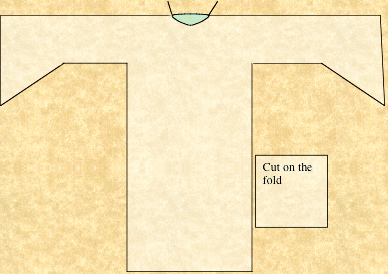

Measure from the neckline to the knee.
Double that length.
Get that many inches of 60 inch wide fabric.
The fabric is already folded length wise. Fold it in half again and lay it out on the floor.
Find a comfortable large t-shirt and fold it in half, sleeves together.
Place the shirt so the fold of the t-shirt is along the side fold edge of the fabric, and the neck opening is at the top fold.
Cut an opening for the neck, not too big.
Cut out the sleeve/body part.
Sew sides together wrong side out, hem length, neck, and sleeves. Add trims.

Trade flourished in the Middle Ages and even small villages would have seen visitors from other countries. If you feel that you are attracted to Germany or Italy or Constantinople please feel free to indulge. The whole point of this is to have fun. We do ask though that you avoid the more modern Gothic interpretations of medieval dress and keep it historic. The park is in Camas and we are not at all sure Camas is ready for a fully-costumed Gothic invasion. The only restriction at this time is the United States. Native Americans were not present on European soil until much later and their existence would not have been known to our little village.

Yes! A medieval wedding was a community event and effort. If you come dressed as a peasant we will ask you to do a peasants job. If you want to be knight you might be asked to protect something and on and on. If you would like to have an actual part in the festivities please email us with your ideas. We also have some of our own and if you indicate your interest we can assign one to you. All of this just makes the day more fun and interesting for all of us. |






